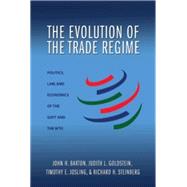
What is included with this book?
| List of Illustrations | |
| Box, and Tables | p. ix |
| Preface | p. xi |
| Political Analysis of the Trade Regime | p. 1 |
| Introduction | p. 1 |
| Understanding the Political Economy of the GATT/WTO Regime | p. 5 |
| State Power and International Trade Institutions | p. 10 |
| Nonstate Actors and Domestic Institutional Design | p. 14 |
| Ideas and Institutional Design | p. 16 |
| Accommodating Changes in Power, Interests, and Ideas | p. 18 |
| Alternative Perspectives on the Trade Regime | p. 22 |
| Creating Constituencies and Rules for Open Markets | p. 27 |
| Why Create a Trade Regime? | p. 29 |
| The GATT 1947 Trade Regime | p. 38 |
| The Early GATT | p. 41 |
| Creating the WTO | p. 47 |
| Making Authoritative Decisions | p. 48 |
| Alternatives to Multilateralism: Preferential Trade Agreements | p. 52 |
| Conclusion: The Trade Regime, Domestic Constituencies, and Free Trade | p. 55 |
| The Politics of the GATT/WTO Legal System: Legislative and Judicial Processes | p. 61 |
| Legislative Rules and Processes --and Transatlantic Power | p. 61 |
| Implementation and Dispute Settlement: The Expansion of Judicial Lawmaking and Transatlantic Power | p. 67 |
| Conclusion: Prospects for Continued Viability of WTO Legislative and Judicial Rules | p. 87 |
| Expanding Trade Rules and Conventions: Designing New Agreements at the Border | p. 91 |
| Introduction | p. 91 |
| The Uruguay Round Tasks | p. 92 |
| Extension of Scope of Trade System | p. 94 |
| Incorporating the "Laggard" Sectors | p. 98 |
| Consolidating the Codes | p. 108 |
| The Un ?nished Business | p. 119 |
| Conclusion | p. 120 |
| Extending Trade Rules to Domestic Regulations: Developing "Behind the Border" Instruments | p. 125 |
| Introduction | p. 125 |
| Bringing in Services: Negotiation of the GATS | p. 127 |
| Health, Agricultural Regulations, and Industrial Standards | p. 135 |
| Intellectual Property Protection and the Trading System | p. 139 |
| The Newest Problems: New Tools, Actors, and Coalitions? | p. 143 |
| The Search for New Principles and New Coalitions | p. 149 |
| Expansion of GATT/WTO Membership and the Proliferation of Regional Groups | p. 153 |
| Introduction | p. 153 |
| GATT/WTO Membership Conditions | p. 154 |
| Increasing Involvement of Developing Countries | p. 160 |
| Different Perspectives and Coalitions | p. 169 |
| Responding to the Concerns of the Developing Nations | p. 172 |
| Preferential Trade Arrangements and Developing Countries | p. 174 |
| Accommodating Nonstate Actors: Representation of Interests, Ideas, and Information in a State-Centric System | p. 182 |
| The Role of Nonstate Actors | p. 183 |
| Complaints about Process: "Underrepresentation" of New Nonstate Actors'Interests | p. 192 |
| Domestic Institutional Processes of Interest Representation and Intermediation | p. 194 |
| Representation at the WTO: The Legislative Process | p. 198 |
| Representation at the WTO: The Judicial Process | p. 199 |
| Conclusions 201 | |
| Conclusions | p. 204 |
| Is Trade Politics "Low" Politics? | p. 205 |
| What Is New about the WTO? | p. 208 |
| An International Bureaucracy | p. 211 |
| Measuring Success | p. 213 |
| In Conclusion: Trade Relations in the Twenty-First Century | p. 214 |
| Bibliography | p. 219 |
| Index | p. 233 |
| Table of Contents provided by Publisher. All Rights Reserved. |
The New copy of this book will include any supplemental materials advertised. Please check the title of the book to determine if it should include any access cards, study guides, lab manuals, CDs, etc.
The Used, Rental and eBook copies of this book are not guaranteed to include any supplemental materials. Typically, only the book itself is included. This is true even if the title states it includes any access cards, study guides, lab manuals, CDs, etc.